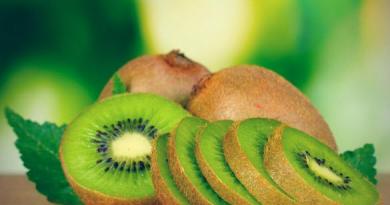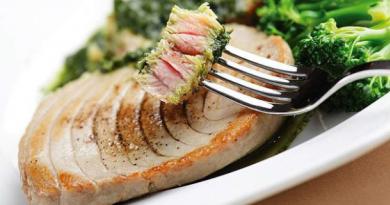Or . However, it is worth taking a closer look at this - it has high taste qualities and a set of useful properties.
What's this?
The vegetable itself belongs to the cabbage genus of the cabbage family. There is a hypothesis that swede appeared as a result of crossing and. This is a biennial plant. After planting, in the first year, a root crop and leaves are formed, in the second year, shoots with yellow flowers, and then seeds. Frost resistant. Feels great on sandy and loamy soils. The root crop of swede can have a different shape depending on the variety - cylindrical, round, oval. Its flesh is firm, white or yellow. The skin, again, depending on the variety, is greenish, purple, yellow, etc. The leaves are fleshy.
Calorie and nutritional value
Rutabaga is a low-calorie vegetable (only 35–37 kcal per 100 g of product), which is attractive to people who watch their figure. It can be consumed raw, fried, baked, boiled. A raw vegetable tastes somewhat reminiscent of, in part.
As for the nutritional value of the product, the useful substances contained in it are clearly not enough for a complete human nutrition. For comparison, the same wheat bread contains about 9 times more protein, 32 times more fat, 6 times more carbohydrates. 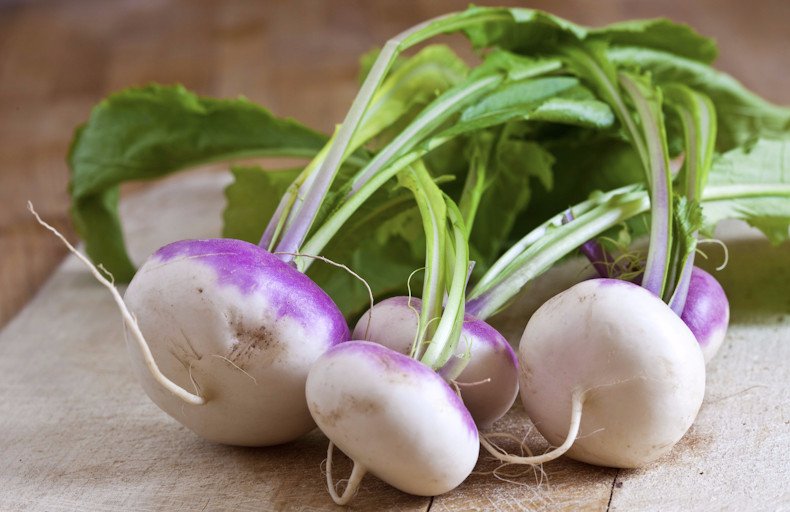 100 g of raw root vegetables contain:
100 g of raw root vegetables contain:
- 0.1 g fat (mustard oil);
- 1.2 g proteins;
- 7.7 g carbohydrates;
- 2.2 g of dietary fiber (fiber);
- 0.2 g organic acids;
- 7.0 g of mono- and disaccharides;
- 87.7 g of water.
Composition of swede
This vegetable contains vitamins A, B1, B2, B5, B6, B9, C, E, H, PP. Rich in vegetables and minerals. 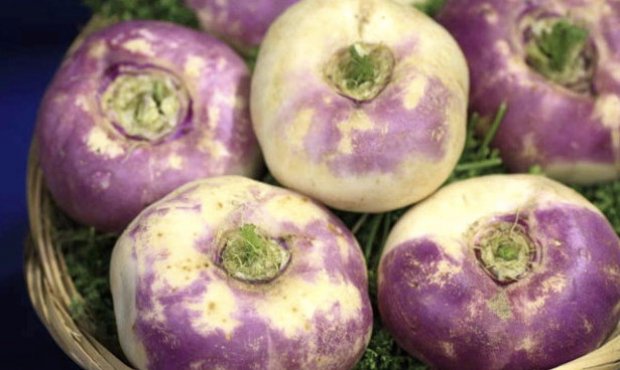 So, in a root crop per 100 g of raw pulp contains:
So, in a root crop per 100 g of raw pulp contains:
- 238 mg potassium;
- 41 mg phosphorus;
- 40 mg calcium;
- 14 mg magnesium;
- 10 mg sodium;
- 1.5 mg iron.
Important! Rutabaga is superior to related turnips in nutritional value and content of nutrients, in particular, in vitamin C. In addition, all useful minerals and vitamins are better preserved during further processing than in other vegetables.
What's the use?
A large amount of potassium in this root vegetable helps to overcome chronic fatigue. Calcium strengthens bones. The presence of vitamins of group B, as well as A, PP, E, H makes it a powerful tool in the fight against beriberi. Vitamin C contributes to the synthesis of hemoglobin and the overall strengthening of the body. In addition, due to the mustard oil it contains, swede is a good diuretic, wound healing and anti-inflammatory agent. 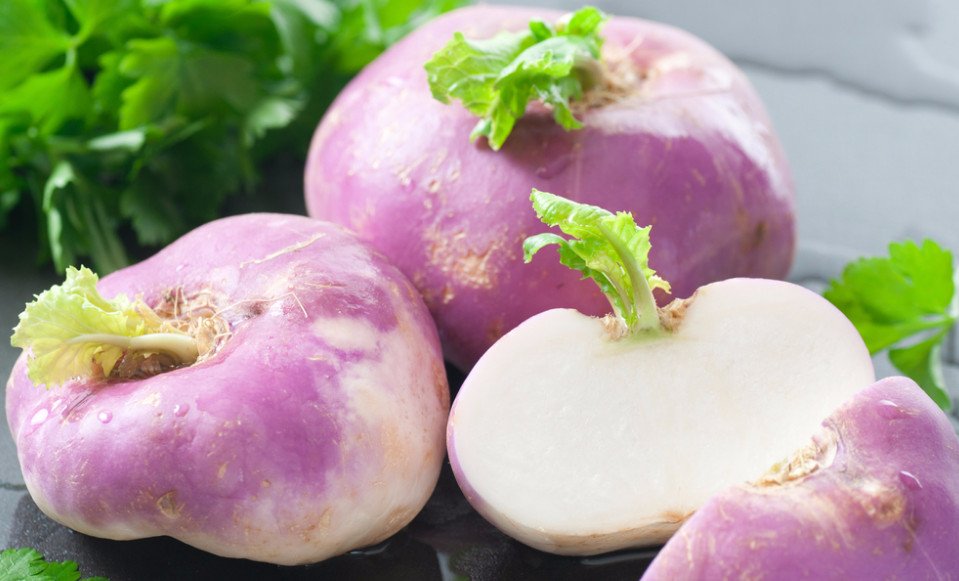 It helps a lot with a dry cough, turning it into a wet cough, which helps the patient recover. Let's not forget about fiber, which is an excellent colon cleanser. Useful properties of swede allow doctors to recommend it for use in constipation and atherosclerosis.
It helps a lot with a dry cough, turning it into a wet cough, which helps the patient recover. Let's not forget about fiber, which is an excellent colon cleanser. Useful properties of swede allow doctors to recommend it for use in constipation and atherosclerosis.
Important! With all the useful properties, in some cases there are contraindications to the use of rutabagas. It should not be eaten by people with problems of the gastrointestinal tract, in such cases, the harm to health clearly outweighs the benefits. Otherwise, there are no restrictions.
How to choose a product
Varieties of rutabaga are table and fodder. The latter are distinguished by the white pulp of the root crop, while the table varieties have yellow flesh. The most popular table varieties are Krasnoselskaya, Swedish Yellow, Wilma. A very juicy and sweet root crop is given by the Lizi variety and the Ruby variety, which is similar in taste to it.
Application
Rutabaga is quite widely used both for medicinal purposes and by nutritionists, as well as cosmetologists.
For treatment
As mentioned above, this vegetable helps a lot with coughing. The root crop should be grated on a fine grater, add a spoonful of honey and leave this gruel to infuse. When juice appears, it is necessary to squeeze it through gauze. The resulting medicine is recommended to be consumed three times a day, one tablespoon. 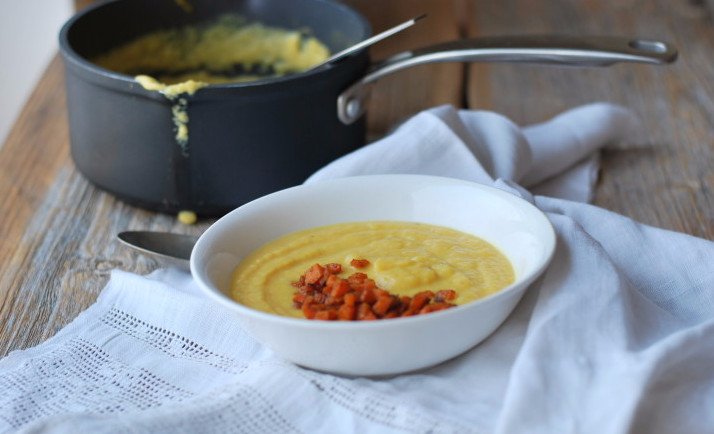 For constipation, the plant is consumed in the form of a puree. To do this, the roots are cut into slices and boiled in water. When the vegetable softens, add a tablespoon of vegetable oil and lemon juice to the pan and boil the product for another 10 minutes. Next, the finished root crop is kneaded in mashed potatoes, which are consumed at night, about 100 g each.
For constipation, the plant is consumed in the form of a puree. To do this, the roots are cut into slices and boiled in water. When the vegetable softens, add a tablespoon of vegetable oil and lemon juice to the pan and boil the product for another 10 minutes. Next, the finished root crop is kneaded in mashed potatoes, which are consumed at night, about 100 g each.
Did you know? In the old days, swede juice was used to speed up the healing of purulent wounds and burns. But since then, medicine has stepped far forward, so in such cases it is still necessary to use modern drugs recommended by doctors. And this vegetable was once treated for measles.
For weight loss
Due to its low calorie content, an impressive set of vitamins and minerals, swede is widely used in various diets for weight loss.  In addition, the fiber contained in the vegetable removes toxins and toxins from the body well, and also improves digestion and metabolism.
In addition, the fiber contained in the vegetable removes toxins and toxins from the body well, and also improves digestion and metabolism.
For skin and hair
Rutabaga juice is rubbed on the face to rid it of acne and rashes. This procedure is carried out daily. In addition, it is believed that the juice of the plant, when regularly rubbed into the scalp, promotes hair growth. On the basis of the mashed root crop, cosmetic vitamin masks are also made. For example, mashed rutabaga is mixed with sour cream to a state of gruel. In the resulting mixture, add one teaspoon and brine. The mask is applied for 10-15 minutes.
In cooking
This vegetable is very popular in Germany, Finland, Sweden and many other countries. In its raw form, it is usually consumed in salads. But this healthy root crop is quite suitable for more complex cooking. Boiled swede tastes somewhat like potatoes and is used as a side dish for meat or fish. The vegetable is also used in soups. Baked with and it is an excellent dessert. 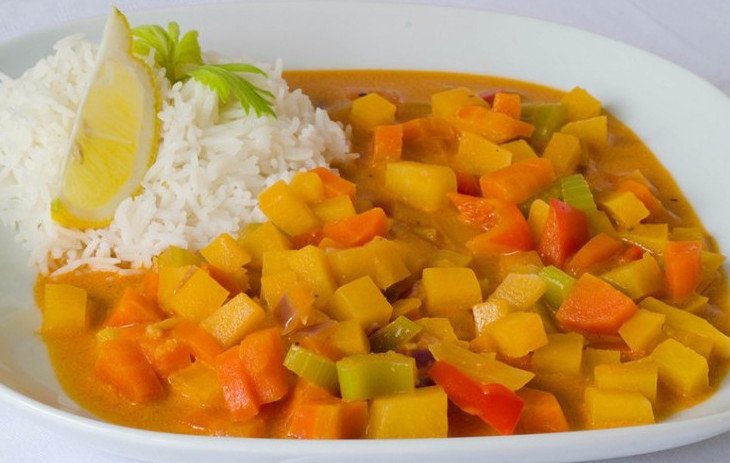 The root crop harmoniously fits into almost any vegetable stew. So, if you fry 350 g of goose meat, put it in a goose, add 100 g of swede and, as well as about 50 g each, pour all 0.5 liters of broth from the bones of a bird, then after a couple of hours of stewing on a minimum fire, you will get a wonderful dish .
The root crop harmoniously fits into almost any vegetable stew. So, if you fry 350 g of goose meat, put it in a goose, add 100 g of swede and, as well as about 50 g each, pour all 0.5 liters of broth from the bones of a bird, then after a couple of hours of stewing on a minimum fire, you will get a wonderful dish .
Harvesting and storage of root crops
The swede is harvested in August-September, depending on the variety and region. At the collected root crops, the tops are cut off under the base, they are cleaned of the ground, dried in the fresh air under a canopy and moved to the cellar, where they are stored in bulk for about a year.
Did you know? In 2011, a photo of Ian Neal from Newport (UK) circulated around the Internet, holding a giant swede with difficulty. The weight of the vegetable grown by him was a record 38.92 kg.
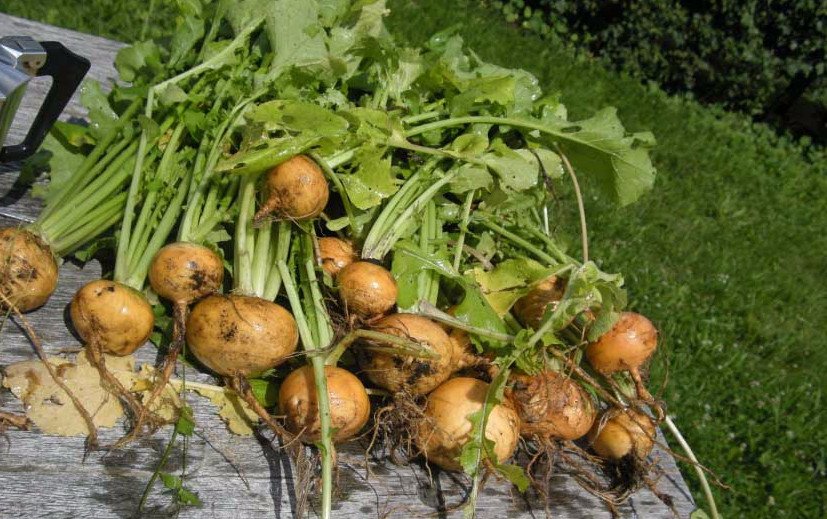 This vegetable can also be stored dried. In this case, the roots are peeled, cut into slices, dried in the fresh air, in the sun. The slices prepared in this way are laid out on a baking sheet and dried in an oven at a temperature of 50-60 ° C. The process continues for 5-6 hours, while the oven door should remain open, and the slices are periodically mixed.
This vegetable can also be stored dried. In this case, the roots are peeled, cut into slices, dried in the fresh air, in the sun. The slices prepared in this way are laid out on a baking sheet and dried in an oven at a temperature of 50-60 ° C. The process continues for 5-6 hours, while the oven door should remain open, and the slices are periodically mixed. Rutabaga is a vegetable, in general, forgotten in our country, and undeservedly. This plant can be widely used for medicinal purposes, for dietary nutrition, in cosmetology and in traditional cooking. For amateur gardeners, its cultivation is not difficult. So it is worth paying attention to this most useful root vegetable.
Was this article helpful?
Not really


